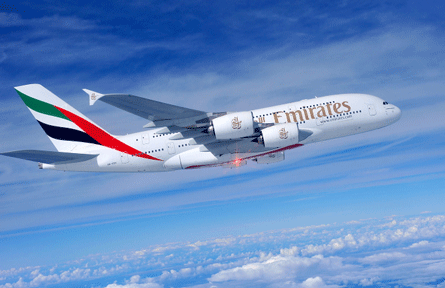Airbus is progressively introducing improvements that will reduce weight by at least 2t on A380s delivered from 2012
Emirates expects its internal drive to reduce operating weights combined with the ongoing weight reduction effort by Airbus will give the A380 a "comfortable 15-15.5h endurance" from 2012. This will open up western USA points such as Houston and San Francisco without significant payload restrictions from Dubai.
"The A380 is only going to get better," says Emirates Airline president Tim Clark. The first aircraft has already turned out to be 1t lighter than expected, and the Airbus programme to cut the manufacturer's empty weight should mean that aircraft delivered from 2012 will be 2t lighter, with more improvements being eyed.
 |
|---|
© Airbus |
"That will mean we will almost be back to the guaranteed nominal weight we signed for in 2000," adds Clark.
Early A380s are almost 5t heavier than originally specified, but Airbus's airframe weight reduction effort is progressively reducing the weight on subsequent aircraft, with the full impact of the effort taking effect on aircraft delivered from 2012.
"This will give the aircraft 2h more endurance, from today's 13-13.5h," says Clark.
While direct flights from Dubai to Los Angeles with an economic payload are problematic in the near term, Clark says he is "very optimistic" that the airline will be able to fly the A380 to San Francisco in the next couple of years.
"By 2012, the A380 will be capable of flying to San Francisco with maximum passengers and some cargo. LAX could be done, but with not with 489 passengers - probably around 400."
To maximise range, Clark says Emirates will probably fly the A380 "slightly slower" than its nominal Mach 0.85 cruise speed. He adds: "The Russians have been hugely accommodating on the polar route exit points so we can fly closer to the great-circle, which gives us 12-20min savings".
In parallel with the Airbus programme, Emirates has set about an initiative to reduce the operating weight of its fleet by up to 2t.
Clark says: "The target is to get 1.5-2t out of the operating items. We're looking at everything from the seats to the curtains."
He adds: "We're trying to get rid of as much 'paper' on our aircraft as possible. We currently have the equivalent of 2kg per seat pocket, which, with 500 passengers on an A380, is 1t."
Emirates has an 18-month project to create a fully interactive online retail channel on its in-flight entertainment system as part of an effort to reduce the size and weight of the in-flight magazines. "The target is to get the weight-per-seat down by 1-1.1kg on all aircraft," says Clark.
The creation of a fleet-wide online channel is not straightforward, however, as Emirates has different specification of IFE equipment on its aircraft, with only the Boeing 777-300ERs and A380s having the latest advanced Panasonic eX2 system.
Clark says the airline is looking at ways of introducing the facility on the less advanced systems that equip its older aircraft such as A340-500s and A330s.
Source: Flight International
















